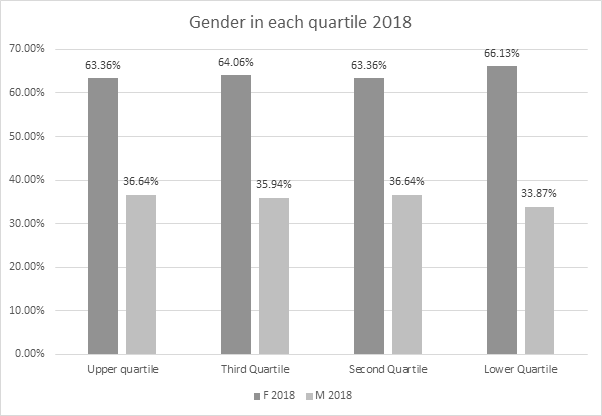Under the Equality Act 2010 (Specific Duties and Public Authorities) Regulations 2017, all public authorities in England with 250 or more employees are required to report their gender pay gap data annually.
The Gender Pay Gap data provides the difference between the average earnings of men and women across an organisation, expressed as a percentage of men’s earnings. The use of Gender Pay Gap data can help to identify the extent to which men and women undertake different types of roles, at different levels within the organisation, which can also create differences in pay. It is different to equal pay data which considers rates of pay for the same level of work.
The data provided below relates to University of Worcester’s Gender Pay Gap report for 2018 taken on the snapshot date of 31 March 2018.
Employment mix within the pay quartiles

It is encouraging to see from our quartile data (the split of employees into four groups by hourly rate, to show the balance of men and women in each group) that women make up over 63% of employees across all four quartiles. This data is indicative of the University’s inclusive approach in all areas of work and the value it places on female employees at all levels.
Mean Pay
The mean is calculated by adding all employees’ hourly rates of pay together and dividing by the total number of employees. The mean includes the lowest and highest rates of pay.
The average hourly rate paid to women at the University, when looking at hourly rates across all pay bands, has reduced to 2.09% less than the hourly rate for men - this is the mean gender pay gap. This is below the national mean gender pay gap of 17.9% (ONS Annual Survey of Hours and Earnings 2018) and is likely to be one of the lowest in universities.
Similar to other organisations, the University employs a higher proportion of women in lower graded roles, for example, our team of cleaners, of whom 85% are women and 15% are men. Having a high percentage of females in roles where there are large numbers of staff contributes to the pay gap shown in our data.
The average hourly rate of pay for women increased as a result of a decision endorsed by the Board of Governors to apply nationally recommended changes to the salary scales, which enabled progression to higher points and also a salary uplift for the lower grades that was a higher % than for other points on the scale. These changes were applied to all colleagues in the relevant grades and as there were a greater number of women within these grades, the impact was greater for them.
Median Pay
The median is the measurement used to calculate the average pay, by finding the midpoint in all employees’ hourly rates of pay. Therefore, half of the employees will earn a rate above the midpoint and half will earn a rate below the midpoint.
The median gender pay gap at the University has reduced substantially in the last 12 months and is 2.16%. This change is a result of restructuring of the salary scales referred to above. The impact of these changes has meant that the median rate of pay for women increased from £14.34 per hour to £16.38 per hour, an increase of 14%. The median salary for men also increased as a result of these changes but as there are fewer men in the lower grades the impact of the changes on the median was lower at 4%.
Bonus Pay
The University operates a staff reward scheme. This provides an opportunity for staff to apply for an incremental pay increase or a one off payment in recognition of outstanding work which has contributed towards the University’s strategic aims. Applications are assessed on a fair and equal basis, by an independent panel.
The total spend on these bonus payments is small when compared with the University’s total spend on salaries and the number of staff involved is comparatively small, 69 people in total. In 2018, women received a higher average bonus payment than men, and the mean gender bonus gap is -3.04%.
The median gender bonus gap for 2018 is 0%.
Moving forward
At the University of Worcester we are committed to inclusion and the promotion of gender equality. Our gender pay gap data demonstrates that we have good foundations in place and that women are well represented at all levels within our organisation.
Moving forward, we will continue to keep our HR policies and processes under regular review to ensure we are making steps towards removing any existing gender pay gap and ensuring that there is a balanced representation of different genders within the workforce and across all roles.
We will continue to monitor the employment ‘lifecycle’ of our staff; from initial recruitment ensuring that we have fair and consistent selection processes; having career development opportunities open for all job roles; clear and consistent promotion and salary processes; fair and flexible working practices.